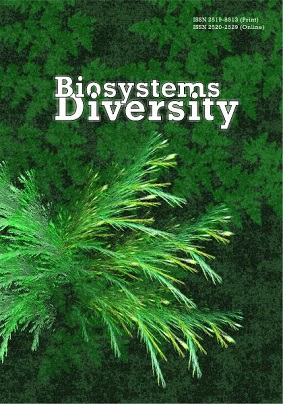The effect of soil and climatic conditions on the distribution of nutrients in Actinidia arguta leaves
The effect of soil and climatic conditions on the distribution of nutrients in Actinidia arguta leaves
Author(s): N. V. Zaimenko, N. V. Skrypchenko, B. O. Ivanytska, D. O. Klymchuk, N. S. Novychenko, D. LiuSubject(s): Agriculture, Human Ecology, Environmental interactions
Published by: Дніпропетровський національний університет імені Олеся Гончара
Keywords: fruit vines; climatic edaphic factor; assimilates; mineral nutrients; remobilization;
Summary/Abstract: The patterns of the distribution of nutrients in kiwiberry (Actinidia arguta (Siebold & Zucc.) Planch. ex Miq.), family Actinidiaceae (Gilg & Werderm), leaves growing under different soil and climatic conditions (Ukraine and China) were studied. Using scanning electron microscopy, significant differences were shown in the distribution of assimilates and mineral nutrients in the leaves of kiwiberry cultivated under different climate and soil conditions (Kyiv city, Ukraine and Jiamusi, China). The leaves of plants grown in China have higher concentration of all of the studied nutrients exception for silicon. The differences found in the content of macro- and microelements in plant tissues are consistent with their total content in the soil, and depend on the synthesis of low molecular weight organic compounds, namely, hydroxybenzoic, benzoic and triterpene acids. An increase in the silicon content in the leaves of kiwiberry plants grown in Ukraine indicates the moisture deficit in the soil. This conclusion is confirmed by the anatomical differences viz. the presence of additional integumentary formations and fewer stomata number per 1 mm2 of leaf surface. The specific feature of ‘Perlyna sadu’ cultivar was high concentrations of sodium and aluminum in the foliar tissues, regardless of the place of growth. The analysis of the distribution of nutrients in the leaves located along the stem showed remobilization of the former within the three layers: the lower one nourishes the roots, the upper one nourishes the leaves in the active growth phase and the middle one allocates the assimilates in both directions. A significant positive relationship was found between the biosynthesis of photosynthetic pigments and electrophysiological activity, especially for the leaves of the lower zone. The revealed differentiation into layers differing in polarity of bioelectric potentials and the distribution of assimilates suggests functional differentiation of the kiwiberry leaves. In particular, the leaves of the lower layer perform a storage function. The middle part is less conservative and characterized by higher sensitivity to environmental factors performs a mainly synthetic function. The upper layer performs an active growth function. The results of the comparative analysis of the indicators of the number of chloroplasts in the mesophyll cells proved that the obtained dependence can be used as a diagnostic criterion in assessing the predicted plant productivity at the early stages of their development.
Journal: Biosystems Diversity
- Issue Year: 28/2020
- Issue No: 1
- Page Range: 113-118
- Page Count: 6
- Language: English

